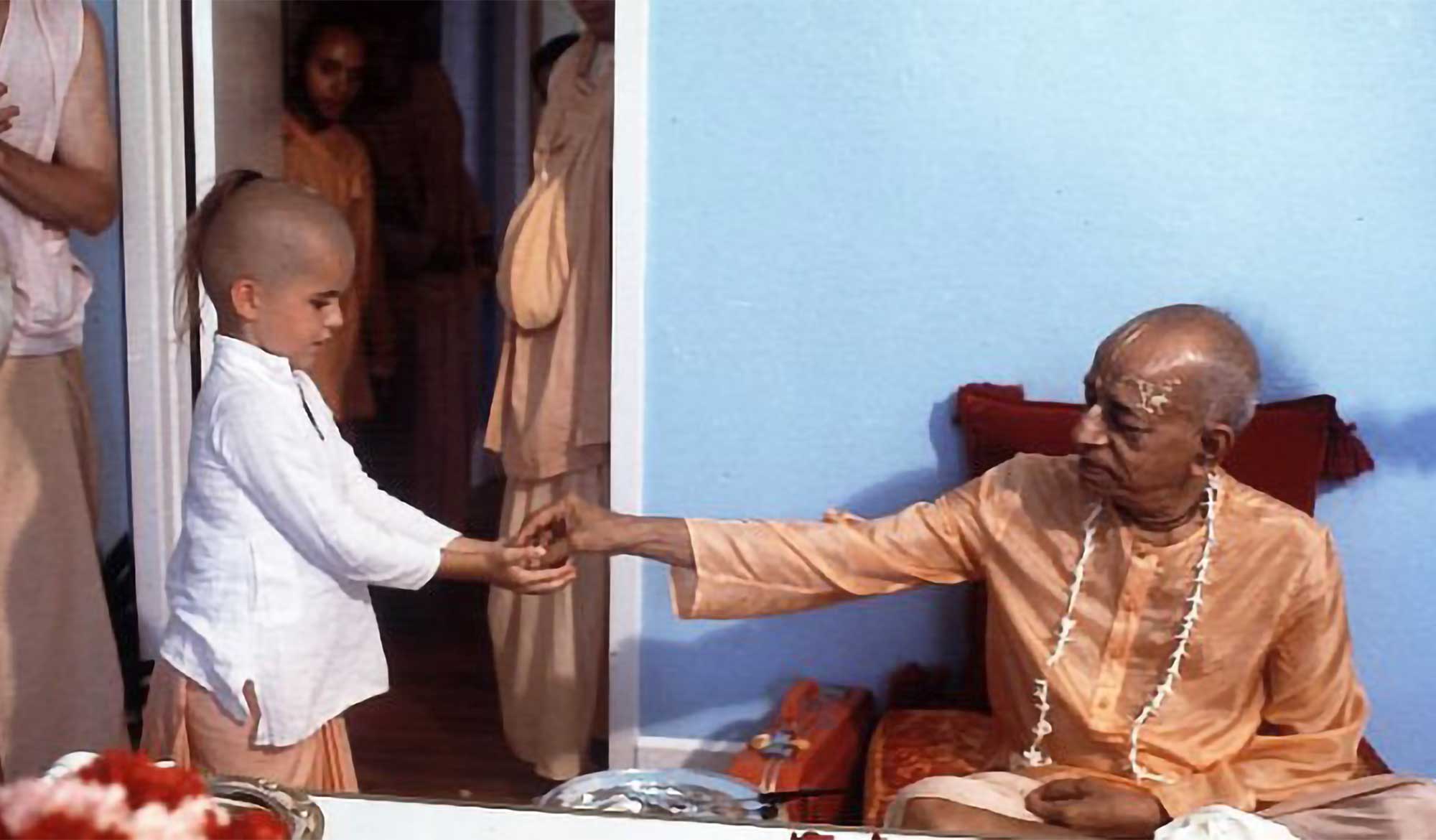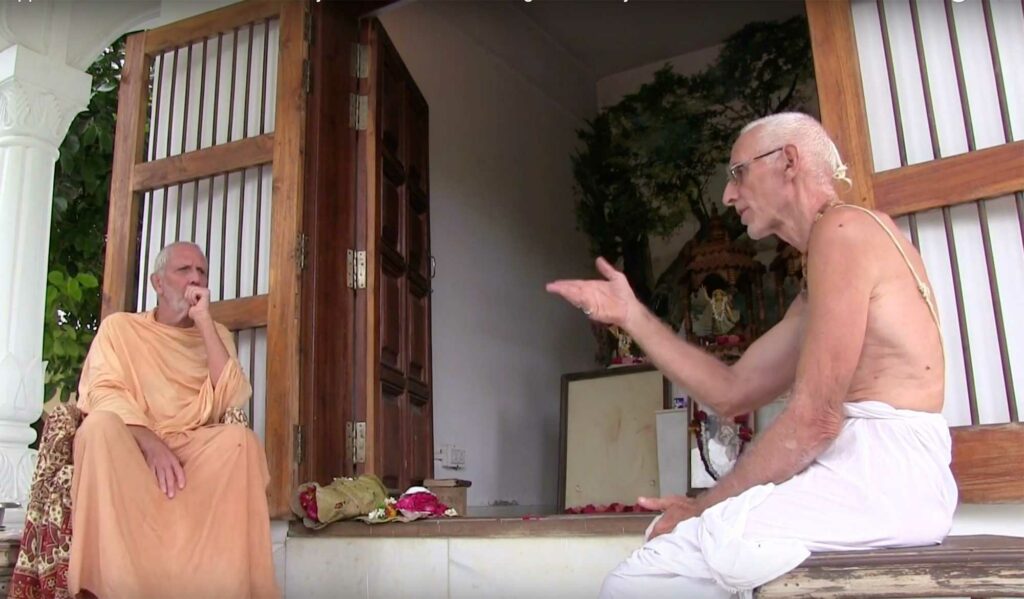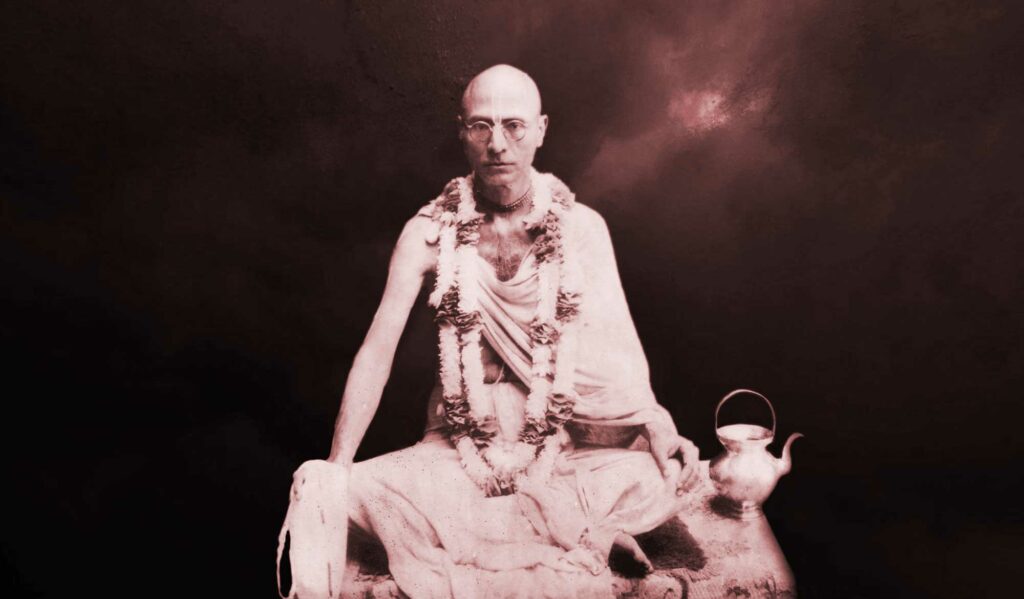Overview
In 'Śrīla Prabhupāda – A Second Generation Devotee's Perspective', Gaura Gopāla Dāsa Brahmacārī shares his realisations about Śrīla A.C. Bhaktivedānta Swami Prabhupāda as a second generation devotee in the Kṛṣṇa Consciousness movement. He discusses how, due to institutionalization, the perception of His Divine Grace can become two-dimensional, especially when there is no substantial connection through a living representative of Śrīla Prabhupāda.
I was born in a family of Hare Kṛṣṇa devotees. Both my mother and father are serious disciples of Śrīla A.C. Bhaktivedānta Swāmī Prabhupāda, but my own experience of becoming seriously interested in Kṛṣṇa consciousness took some time to develop.
Being born in a devotee family surrounded by the contributions of Prabhupāda in the form of Gaura-Nitāi Deities at home, spiritual literature, audio lectures, devotee communities and so on, can actually desensitise you to the wealth that is woven through all these things. In such a situation these gifts can sometimes be seen as unremarkable or ordinary, and a certain amount of disappointment seeing lifelong disciples lacking any enthusiasm or a genuine serving-attitude serves to dilute it even further.
However, the reality is that every practising Vaiṣṇava in the western world must acknowledge and show respect to Śrīla Prabhupāda for his contributions. As I’ve come in touch with various devotees throughout my life, I see how each and every one of them has been affected directly or indirectly by the teachings of His Divine Grace.
What gave me the opportunity to acquire a more down to earth perspective, which ultimately led to a deeper understanding and feeling for Śrīla Prabhupāda and Kṛṣṇa Consciousness in general, was coming in touch with my guru, Śrīla Bhakti Gaurava Narasiṅgha Mahārāja.
Being a dedicated disciple of his gurus (Śrīla A.C. Bhaktivedānta Svāmī Prabhupāda, Śrīla Bhakti Rakṣaka Śrīdhara Deva Gosvāmī and Śrīla Bhakti Pramoda Purī Gosvāmī), he showed an exemplary understanding of guru-tattva. His dedicated serving spirit combined with an unconventional, no BS attitude showed me how Kṛṣṇa consciousness is a living, breathing force that moves independently of any institution, big or small. This flow cannot be dammed or controlled – Śrī Guru and Kṛṣṇa can be present wherever They want to be according to Their own sweet will. In a more focused way, I continued to learn more about who Śrīla Prabhupāda was, both in a historical sense and also in relation to his internal mood – more than I had heard anywhere else.
Some Vaiṣṇavas are a clear window through which to see guru and Kṛṣṇa, and some, despite having something to offer, often obscure more than they show. The fact is that it is not just people born into the saṅkīrtana movement, but also those who joined in the first and second waves that have become accustomed to an institutional vision of our param-guru – a two-dimensional messiah figure made to fit a very low-resolution narrative. For example, in many expressions glorifying Śrīla Prabhupāda, you could simply replace the name ‘Prabhupāda’ with Jesus. In other words, devotees begin to sound like born-again Christians. This is so prevalent that the living guru principle has been relegated to a back seat, and in the case of the modern day Ṛtvik movement, it is been taken out of the picture altogether. This misconception is not limited to the hard-line Ṛtviks – many devotees who are initiated by a first or second generation guru see Prabhupāda as their main shelter and their initiating guru merely as a facilitating agent. In other words Prabhupāda is the actual deliverer guru and their initiating guru is simply an instrumental guru. My Guru Mahārāja used to call this ‘covered Ṛtvik’.
The reality is that my relationship with Śrīla Prabhupāda and all my param-gurus and parat-para-gurus is through my personal relationship with my Guru and the living Vaiṣṇavas with whom I associate. You can understand the presence of Śrīla Prabhupāda through the living presence and association of those who served him and whose lives were changed by him. I received the Holy Name and my dīkṣā-mantras from my guru who received them from Śrīla Prabhupāda, who received them from Bhaktisiddhānta Sarasvatī Ṭhākura etc., all the way back to Kṛṣṇa – this is the real understanding of paramparā. The divine flow is coming all the way from the source through the line of self-realised souls, we are connected to all of them but first we are a servant of our own guru. It begins there.
I’ve heard all the Prabhupāda ‘miracle’ stories as a kid around the Iskcon movement (Prabhupada’s feet not touching the ground, taking on everyone’s sins, talking to animals, etc) as well as a lot of fanatical praise of His Divine Grace that lacks any real substance. It doesn’t enter the heart. It’s like spiritual fast food – it tastes good at first, but has no nutritional value. It could be argued that these miracle stories stem from the western Christian saṁskāras resembling apocryphal tales of Christian saints created by the clergy to instill faith in the hearts of laymen. Prabhupada’s real miracle was transplanting the culture of Kṛṣṇa in the west to so many mlecchas who lacked any vaiṣṇava culture.
On the other hand, when you are able to come in touch with someone who acts and speaks with real conviction, who has deep faith in their guru and this path to the Infinite, then it strikes to the very core of the heart. It inspires real faith within, along with the desire to take action based on that.
My Guru Mahārāja once told me that while visiting a godbrother in Vṛṇdāvana, he saw something which struck him. His godbrother began to tell a Prabhupāda story and out of the corner of his eye, my Guru Mahārāja noticed this person’s personal servant rolling his eyes. He said that this devotee wasn’t rolling his eyes out of disrespect, but out of frustration because the overarching mood behind the godbrother narrating this Prabhupāda story was, “You missed out! We got something that you will never get!”
The mentality that, “No one can love their guru like I love my guru!” is both immature and false. Moreover, āmāra guru jagat-guru (‘my guru is the guru of the universe!’) isn’t a very well-developed idea. If anything, this kind of attitude screams, “My guru is great because I’m his disciple! If I wasn’t his disciple then he wouldn’t be so great!” The understanding of akhaṇḍa-guru-tattva (the indivisible guru-principle) is totally missing in this mindset. According to the necessity of the disciple, Kṛṣṇa manifests Himself through various individual gurus, but everything ultimately leads to Śrī Kṛṣṇa, the original guru-principle.
When you divorce the deep philosophy of guru-tattva from the guru, all you are left with is stories. Stories are only useful as vehicles for the siddhanta in order to help others. When one praises the guru but neglects the philosophy, one becomes a prisoner in the land of sentimentality.
As my Guru Mahārāja once said:
The greatness of Śrīla Prabhupāda is not understood or expressed by concoction or sentimental exaggeration. The transcendental position of His Divine Grace can only be realised when one sees how Śrīla Prabhupāda is connected to the paramparā of great masters, and what qualifications earned him that illustrious position. The bona-fide disciple earns this right of divine vision through a lifetime of service and dedication at the lotus feet of the spiritual master – not by any amount of mundane speculation. There is no other way to the truth than this.
The real understanding of one’s guru can mature only when one perceives the guru as a perfect disciple of his own guru. Anyone who primarily identifies himself as a guru but not as a disciple is bewildered. The genuine approach is to become a perfect disciple – the aspect of becoming a guru only manifests as a consequence of following the guru’s instructions perfectly.
There is so much that can be said in relation to service providing us with that divine vision. In a gist the dedicated spirit and service are what will begin to open our eyes to the realm of spiritual realisation. This service, along with the fire of ordeal in pursuit of that, is the proving ground of the disciple, and that attracts the divine grace of the whole guru-varga.
As Śrīla Prabhupāda himself said, “Sometimes the grandfather is more merciful than the father.” This should be our vision of our param-gurus. They are not dead and gone. They are present in the sound coming from the lips of the living guru. He is a product of their compassion, and he in turn is giving as much as he can to whoever will take it.
The transaction of service to the guru is a mystical process. If approached with real sincerity and the right consciousness it has the capacity to unfold the layers leading to the Infinite. The śāstra that we have read so many times before takes on new and profound meanings. The instructions of the guru carry more weight and we find depth that we didn’t realise was there before. We are approaching the Infinite. It doesn’t have a finishing line. This is why we hear descriptions of Ananta Śeṣa being unable to finish speaking the glories of Lord Viṣṇu even with His millions of mouths. The guru, who becomes a knowing or unknowing medium for that plane of the Infinite, should be seen in the same way.
One cannot understand personalities like Śrīla Prabhupāda through books alone. The books are incredibly powerful, but we need to come in touch with a living agent who is practising what he preaches. Such sādhu-saṅga combined with studying such books will be most effective together.
You also cannot understand great personalities through those who have no significant realisation. You cannot give what you yourself don’t have. You cannot give love of God, or a taste for chanting the Holy Name to someone when you yourself don’t possess it. It takes one to know one, and it takes one to give it.
My understanding of Śrīla Prabhupāda began with my parents’ pursuit of an authentic Kṛṣṇa conscious life after coming in touch with him. They later came in touch with Śrīla Bhakti Gaurava Narasiṅgha Mahārāja and this was the beginning of my own evolution – a deep dive into what this is all about. Now, in the association of my guru’s godbrother Śrīpāda Bhakti Kiśora Āraṇya Mahārāja, it has been further refined. Their heartfelt attitude enhances what I’ve heard so much about. The long road to the Infinite is a lonely place without the company of these souls of determined character. May I never be without their company.
Related Articles
- 📖 Prabhupāda Vijaya (Book)
- My Guru is Rādhārāṇī by Śrīla Bhakti Gaurava Narasiṅgha Mahārāja
- Become Guru! by Śrīla Bhakti Gaurava Narasiṅgha Mahārāja
- Purport to Śrīla Prabhupāda-līlā Smaraṇa-Maṅgala Stotram by Śrīla Bhakti Gaurava Narasiṅgha Mahārāja
- Mahāprabhu as Prabhupāda by Śrīla Bhakti Gaurava Narasiṅgha Mahārāja
- How Great is Śrīla Prabhupāda? by Śrīla Bhakti Gaurava Narasiṅgha Mahārāja
- A Few Words on the Rasa of Śrīla Prabhupāda and the ‘Suicide Squad’ by Śrīla Bhakti Gaurava Narasiṅgha Mahārāja
- The Prākṛta and Aprākṛta-līlā of Śrī Guru by Śrīla Bhakti Gaurava Narasiṅgha Mahārāja
- The Golden Age of the Saṅkīrtana Movement by Śrīla Bhakti Gaurava Narasiṅgha Mahārāja
- Bhaktivedānta by Śrīla Bhakti Gaurava Narasiṅgha Mahārāja
- The Disappearance of a Śaktyāveśa-avatāra by Śrīla Bhakti Gaurava Narasiṅgha Mahārāja
- Śrīla Prabhupāda – A Second Generation Devotee’s Perspective by Gaura Gopāla Dāsa
Pilgrimage with Swami Narasiṅgha – Part 7: Keśī Ghāṭa
Continuing with our pilgrimage series, this week Śrīla Narasiṅgha Mahārāja takes us to Keśī Ghāṭā where he tells us about Madhumaṅgala’s meeting with the Keśī demon, what Keśī represents, and how Śrīla Prabhupāda almost acquired Keśī Ghāṭa. Mahārāja also narrates his own experience. This article has been adapted from a number of talks and articles by Narasiṅgha Mahārāja.
Prema Dhāma Deva Stotram with the Narasiṅgha Sevaka Commentary – Verses 61-65
In verses 61 to 65 of 'Prema Dhāma Deva Stotram', Śrīla Śrīdhara Mahārāja narrates the pastime of Śrī Caitanya at Caṭaka Parvata In Purī and explains how the scriptures produced by Brahmā and Śiva are ultimately searching for the personality of Mahāprabhu who is merciful too all jīvas, no matter what their social position.
Prabhupāda Śrīla Sarasvatī Ṭhākura’s Visit to Ayodhyā
With the forthcoming observance of Śrī Rāma Navamī, we present 'Prabhupāda Śrīla Sarasvatī Ṭhākura’s Visit to Ayodhyā' written by Śrīla Bhaktisiddhānta Sarasvatī Ṭhākura Prabhupāda from The Gaudīyā magazine, Vol 3. Issue 21/ In December 1924, after visiting Benares and Prāyāga, Sarasvatī Ṭhākura visited the birth-site of Śrī Rāmācandra in Ayodhyā.
Śaraṇāgati – The Only Path to Auspiciousness
In this article, 'Śaraṇāgati - The Only Path to Auspiciousness', Dhīra Lalitā Dāsī analyses the process of śaraṇāgati (surrender) beginning with śraddhā (faith). She also discusses the role of śāstra and the Vaiṣṇava in connection with surrender.
Pilgrimage with Swami Narasiṅgha – Part 7: Keśī Ghāṭa
Continuing with our pilgrimage series, this week Śrīla Narasiṅgha Mahārāja takes us to Keśī Ghāṭā where he tells us about Madhumaṅgala’s meeting with the Keśī demon, what Keśī represents, and how Śrīla Prabhupāda almost acquired Keśī Ghāṭa. Mahārāja also narrates his own experience. This article has been adapted from a number of talks and articles by Narasiṅgha Mahārāja.
Prema Dhāma Deva Stotram with the Narasiṅgha Sevaka Commentary – Verses 61-65
In verses 61 to 65 of 'Prema Dhāma Deva Stotram', Śrīla Śrīdhara Mahārāja narrates the pastime of Śrī Caitanya at Caṭaka Parvata In Purī and explains how the scriptures produced by Brahmā and Śiva are ultimately searching for the personality of Mahāprabhu who is merciful too all jīvas, no matter what their social position.
Prabhupāda Śrīla Sarasvatī Ṭhākura’s Visit to Ayodhyā
With the forthcoming observance of Śrī Rāma Navamī, we present 'Prabhupāda Śrīla Sarasvatī Ṭhākura’s Visit to Ayodhyā' written by Śrīla Bhaktisiddhānta Sarasvatī Ṭhākura Prabhupāda from The Gaudīyā magazine, Vol 3. Issue 21/ In December 1924, after visiting Benares and Prāyāga, Sarasvatī Ṭhākura visited the birth-site of Śrī Rāmācandra in Ayodhyā.
Śaraṇāgati – The Only Path to Auspiciousness
In this article, 'Śaraṇāgati - The Only Path to Auspiciousness', Dhīra Lalitā Dāsī analyses the process of śaraṇāgati (surrender) beginning with śraddhā (faith). She also discusses the role of śāstra and the Vaiṣṇava in connection with surrender.








